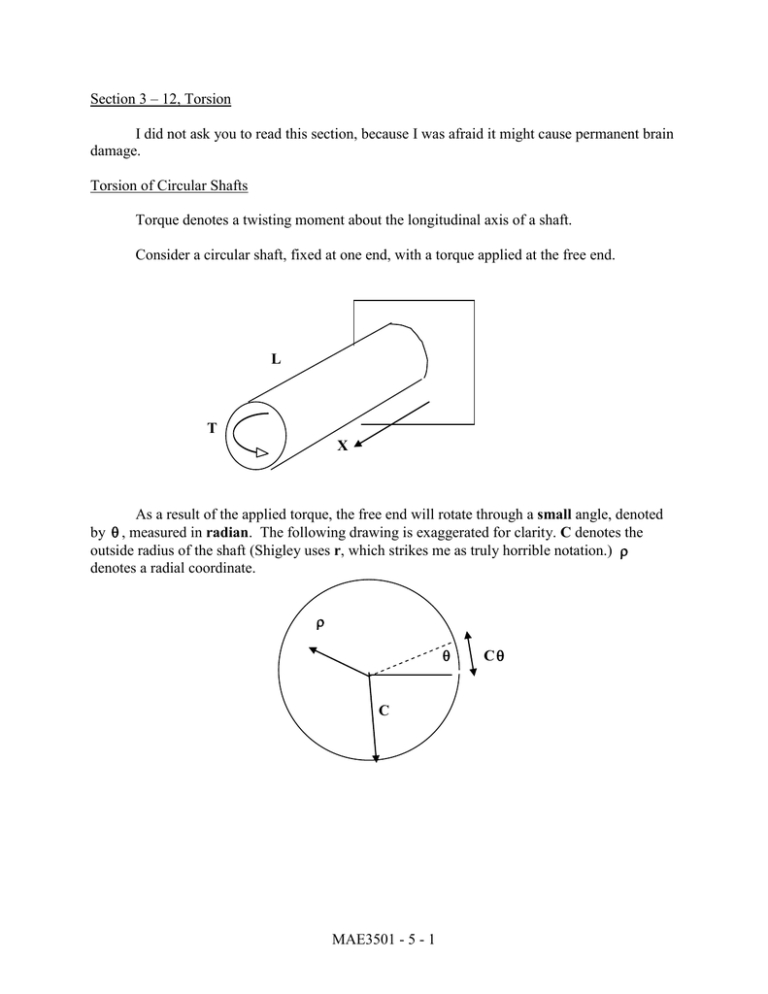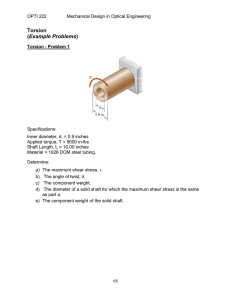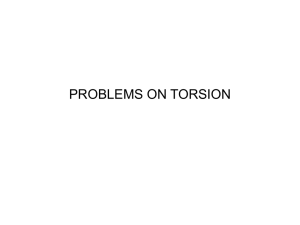Section 3 – 12, Torsion
advertisement

Section 3 – 12, Torsion I did not ask you to read this section, because I was afraid it might cause permanent brain damage. Torsion of Circular Shafts Torque denotes a twisting moment about the longitudinal axis of a shaft. Consider a circular shaft, fixed at one end, with a torque applied at the free end. L T X As a result of the applied torque, the free end will rotate through a small angle, denoted by , measured in radian. The following drawing is exaggerated for clarity. C denotes the outside radius of the shaft (Shigley uses r, which strikes me as truly horrible notation.) denotes a radial coordinate. C MAE3501 - 5 - 1 C The following relationships were developed in Strength of Materials. J= 2 C4 C4 = 4 2 (5.1) J is referred to as the torsional constant of the cross section, and is expressed in units of inch or m 4 . 4 T J MAX (5.2) TC J (5.3) TL JG (5.4) If the shaft is hollow, the following relationship results. ( CO 4 C I 4 ) J= 2 (5.5) Engineers generally refer to the diameter, not the radius, of a cylindrical object. Therefore, the following two relationships will be of more value. Solid shaft. J= D4 32 (5.6) Hollow shaft. ( DO 4 DI 4 ) J= 32 (5.7) To determine the torque in some portion of a shaft, pass a section through that portion of the shaft and add up all the torques applied to the shaft on one side of the section. It does not matter which side. MAE3501 - 5 - 2 Example The solid, 30 mm-diameter shaft transmits the torques shown. Determine the maximum absolute value of shear stress. C 15 mm 0.015 m J (E.1) D 4 (0.030) 4 79.5 (10) 9 m 4 32 32 (E.2) TAC 300 N m (E.3) TCD 200 N m (E.4) TDB 400 N m (E.5) MAX TMAX C J 400 (0.015) 79.5 (10) 9 75.5 (10) 6 Pa 75.5 MPa MAE3501 - 5 - 3 (E.6) Power Transmission An engineer will not generally know the torque. Instead, the engineer will know the power transmitted to a shaft and the rotational speed of the shaft. It is therefore necessary to develop the relationship for torque in terms of power and rotational speed. The relationship is straightforward, but is complicated by unit conversion. The power delivered to a rotating shaft is equal to the product of the torque and the angular velocity of the shaft, measured in radian/sec. PT (5.8) The following conversion factors will be of value. 1 hp 550 ft lb s (5.9) 1 hp 0.746 kW (5.10) rev rad 2 s s (5.11) 1 1 rpm 2 radian 0.105 60 s MAE3501 - 5 - 4 (5.12) Example The A-36 steel tubular shaft is 2 m long and has an outer diameter of 50 mm. When it is rotating at 40 rad/s, it transmits 25 kW of power from the motor to the pump. Determine the torque applied to the shaft. 40 radian s P 25 kW 25 T (E.1) kJ kN m 25 s s P 25 0.625 kN m 40 Note that L, G, and J are not used in this problem. MAE3501 - 5 - 5 (E.2) (E.3) Example The A-36 solid steel shaft is 2 m long and has an outer diameter of 60 mm. It is required to transmit 60 kW of power from the motor to the pump. Determine the smallest angular velocity at which the shaft can turn if the allowable shear stress is 80 MPa. P 60 kW 60 kN m s (E.1) D 60 mm 0.060 m (E.2) C 0.030 m (E.3) J D4 1.27 (10) 6 m 4 32 (E.4) ALLOW 80 MPa 80 (10) 3 kPa (E.5) ALLOW J 3.39 kN m C (E.6) TMAX P TMAX MIN MIN P TMAX 17.7 (E.7) rad 169 rpm s L and G are not used in this problem. MAE3501 - 5 - 6 (E.8) Torsion of Non-Circular Sections Saint-Venant’s Approximation Discuss an approximation that is not, unfortunately, in any modern textbook. An analysis of the torsion of a solid, circular shaft leads to the following relationships. TL JG J IP (5.13) C4 C 2 2 dA (2 d) 2 AREA 0 (5.14) Somehow, Barre de Saint-Venant noticed the following relationship. J A4 4 2 IP ( C 2 )4 C4 4 2 2 C 4 2 (5.15) He then postulated that this relationship might provide a good estimate of the torsional stiffness of “squatty” sections. Consider a rectangle with a length-to-width ratio of N. N Y 1 Z A 1 ( N) N IP AREA IP 2 (5.16) dA ( Y 2 Z 2 ) dA I Z I Y AREA N (1) 3 N 3 (1) N ( N 2 1) 12 12 12 J EST (5.17) 12 N 4 (5.18) (5.19) 4 2 N ( N 2 1) MAE3501 - 5 - 7 Compare this estimate of the torsional stiffness of a rectangular shaft with “exact” solutions. N Estimated Exact 1 0.152 0.141 2 0.486 0.229 5 1.46 0.291 Pretty good for a square, not close for a 2 by 1 rectangle, and horrible for a 5 by 1 rectangle. This was a valuable approximation in the middle of the nineteenth century. However, all “real” shapes have undoubtedly been analyzed by a digital computer. Therefore, of what value is such an approximation today? MAE3501 - 5 - 8 Example Consider this very real problem, a circular shaft with an essentially square keyway. The width of the keyway is equal to one-third the radius of the circular shaft. Y Z The entire analysis is approximate. Therefore, model the cut-out area as a square with a C side length equal to . 3 Without the keyway, J C4 1.57 C 4 2 (E.1) With the keyway, 2 C A C 3.03 C 2 3 2 (E.2) Determine the Y - coordinate of the centroid of the section, measured positive upward from the center of the shaft. C2 5 C 2 C 0 9 6 YC 0.0306 C (E.3) 2 3.03 C MAE3501 - 5 - 9 Determine the polar moment of inertia of the section about its centroid, making use of the parallel-axis theorem. Calculate two terms, the polar moment of inertia of the circular shaft about the centroid of the section and the polar moment of inertia of the keyway about the centroid of the section. I P ,S 4 I P ,K C4 C 2 (0.0306 C) 2 1.60 C 4 2 4 C C 2 C2 5 C 3 3 0.0306 C 0.0850 C 4 12 9 6 I P I P,S I P,K 1.52 C4 J EST ( 3.03 C 2 ) 4 4 1.52 C 2 (E.4) 4 1.40 C 4 : (E.5) (E.6) (E.7) Problems of this type are not common, but when such a problem arises it is much easier to use Saint-Venant’s approximation than to perform a numerical-analysis solution of the governing partial differential equations. The estimated value of J may be used to estimate . It must never be used to estimate . In this example, the shear stress at the bottom corners of the keyway would be very large, infinite for a true right angle. In practice, keyway corners are always rounded to reduce the stress concentrations at those locations. MAE3501 - 5 - 10 The following results are developed in graduate courses such as MAE 5201. For a long, slender rectangle. Y Z C L L C (5.20) L C3 J 3 (5.21) The torsional stiffness of a long, slender rectangular cross section is proportional to its length and proportional to the cube of its width. XZ 2TY J XZ , MAX (5.22) C 2T 2 J (5.23) Except near the ends of the rectangle, the shear stress is parallel to the long axis of the rectangle and proportional to the distance from the centerline of the rectangle. If you ask me what ratio of L to C is required to satisfy equation (5.20), I don’t know. All I can tell you is that the larger the L-to-C ratio, the more accurate equations (5.21) through (5.23) become. Unfortunately, there is no straightforward method to calculate the “correct” answer, so it is not possible to determine the manner in which accuracy decreases as the L-to-C ratio decreases. MAE3501 - 5 - 11 Thin-Walled, Open Cross Sections Consider the torsion of shafts with thin-walled open cross sections, such as the following. These cross sections are composed of long, slender rectangular areas. C I denotes the width of the I-th rectangle. L I denotes the length of the I-th rectangle. L I CI 3 J 3 I (5.24) Determine the maximum shear stress in the I-th rectangle. MAX, I C 2T I 2 J (5.25) The maximum shear stress on the cross section occurs in the rectangle with the larger or largest width. This makes perfect sense. Consider the torsion of a shaft with a cross section composed of a thin rectangle and a very thin rectangle. Only the thin rectangle resists the torsion of the shaft. The very thin rectangle just goes along for the ride, completely unstressed. Shigley presents similar relationships, except he requires the thicknesses of the rectangular areas to be the same. This is somewhat foolish, as thin-walled, open structural sections frequently have different thicknesses, e.g., the flanges and shear web of an I- beam. MAE3501 - 5 - 12 Example Determine J for the following cross section. Dimensions are inch. 10 1 8 0.5 J 10 (1) 3 7 (0.5) 3 3.625 inch4 3 3 (E.1) J 9.5 (1) 3 8 (0.5) 3 3.50 inch4 3 3 (E.2) Or There is no correct answer. If I were required to analyze the torsion of this cross section, I would use the average of the two results. Of course, as the thicknesses of the rectangular areas decrease, the two solutions will approach each other. MAE3501 - 5 - 13 Thin-Walled, Closed Cross Sections Consider the torsion of a shaft with a thin-walled, closed cross section, such as a box beam. . t The thickness, t, may vary, although it would almost certainly be constant along any portion of the cross section. The thickness, t, is small compared to the dimensions of the cross-section. J 4 A2 dl t (5.26) T 2At (5.27) In the above relationships, l, lower-case L, denotes a coordinate along the mid-line of the thin-walled section. A denotes the area inside the mid-line of the section. The maximum shear stress occurs where the wall thickness is minimum. MAE3501 - 5 - 14 Example Determine J, the torsional constant for the following cross section. Dimensions are in inch. All wall thicknesses are equal to 0.5 inch, except the wall thickness shown. 8 1.0 inch 10 A (8 0.5 0.25) (10 0.25 0.25) 69.2 inch2 dl 9.5 7.25 9.5 7.25 57.5 t 1.0 0.5 0.5 0.5 4 A 2 4 (69.2) 2 J 333 inch4 dl 57.5 t MAE3501 - 5 - 15 (E.1) (E.2) (E.3) If you ask me how small t must be in order for equations (5.26) and (5.27) to be correct, I cannot give you a quantitative answer. However, I can get a feel for the problem by considering the following two examples. Example A hollow, circular shaft, outside diameter of 2.1 inch, and inside diameter of 1.9 inch, is subjected to a torque of 1.0 kip inch . Determine J and MAX . Note that the wall thickness is equal to 0.1 times the average radius of the section. Exact: J= ( DO 4 D I 4 ) ( 2.14 1.9 4 ) 0.630 inch4 32 32 MAX T C 1.0 (1.05) 1.67 ksi J 0.630 (E.1) (E.2) Thin-walled, closed: J 4 A 2 4 [ (1.0) 2 ]2 0.628 inch4 dl ( 2.0) t 0.1 MAX T 1.0 1.59 ksi 2 A t 2 (1.0) 2 (0.1) (E.3) (E.4) Very close for the torsional constant of the section, about 5 % difference in the maximum shear stresses. MAE3501 - 5 - 16 Example A hollow, circular shaft, outside diameter of 2.2 inch, and inside diameter of 1.8 inch, is subjected to a torque of 1.0 kip inch . Determine J and MAX . Note that the wall thickness is equal to 0.2 times the average radius of the section. Exact: J= ( DO 4 D I 4 ) ( 2.2 4 1.8 4 ) 1.27 inch4 32 32 MAX T C 1.0 (1.1) 0.866 ksi J 1.27 (E.1) (E.2) Thin-walled, closed: J 4 A 2 4 [ (1.0) 2 ]2 1.26 inch4 dl ( 2.0) t 0.2 MAX T 1.0 0.796 ksi 2 A t 2 (1.0) 2 (0.2) (E.3) (E.4) Still very close for the torsional constant of the section, about 9 % difference in the maximum shear stresses. MAE3501 - 5 - 17 Homework The following two cross sections are subjected to a torque T 1.0kip inch . Determine the maximum shear stress in each section. dimensions are in inch. 1. 7.5 0.5 8.5 0.75 2. 7.0 9.0 0.75 All other wall thicknesses are equal to 1.0 inch. MAE3501 - 5 - 18





